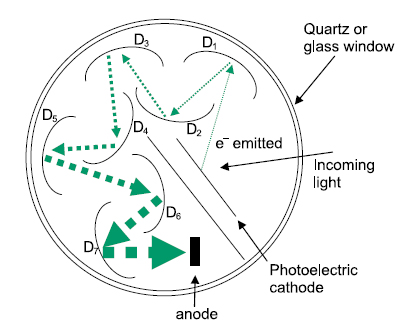Optipedia • SPIE Press books opened for your reference.
Photomultiplier Tubes
Excerpt from Field Guide to Spectroscopy
One type of photon detector is the photomultiplier tube (or PMT). A PMT is similar to a phototube in that it has a photoelectric cathode that absorbs light and emits an electron. A PMT also contains other electrodes in sequence called dynodes. Each dynode is kept at a higher positive voltage than the preceding one, with a total voltage drop that can exceed 2500 V. Electrons are attracted to each successive dynode, and upon striking the dynode they knock off several additional electrons from the dynode. As the electron stream travels from dynode to dynode, more and more electrons are emitted as part of a cascade. At the final anode, 104-108 electrons may be produced for every electron emitted from the cathode.

PMTs can detect IR, visible, and UV light, and can be very sensitive and have very fast response times. Some are cooled to minimize dark current. Many are so sensitive that they can be burned out if the incoming light is too bright.
D. W. Ball, Field Guide to Spectroscopy, SPIE Press, Bellingham, WA (2006).
View SPIE terms of use.

